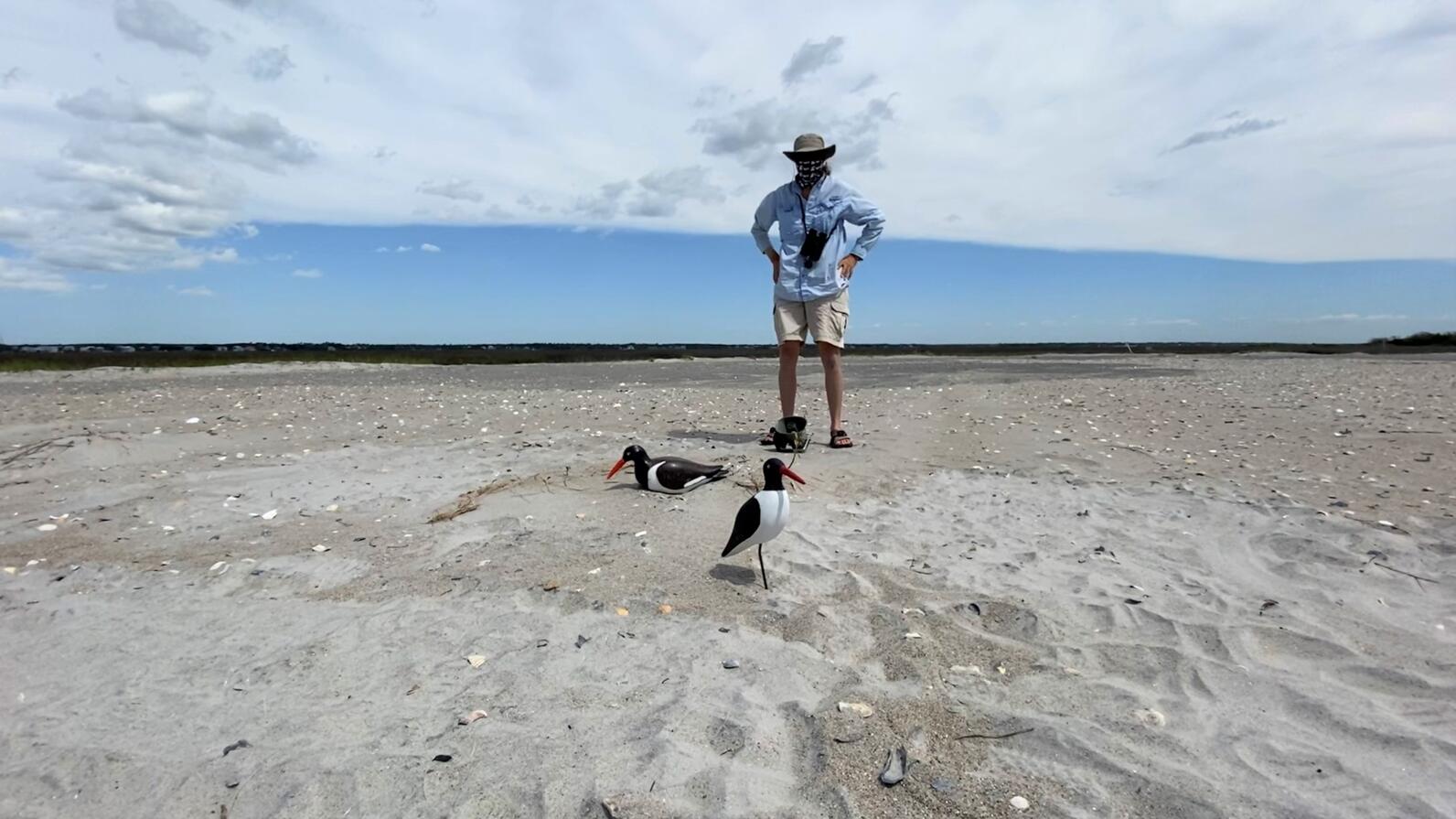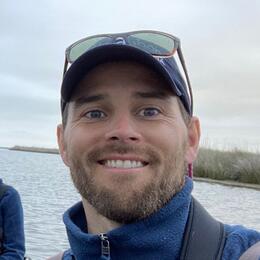With its bright orange bill and dinosaur-like legs, the American Oystercatcher is hard to miss on North Carolina’s beaches. But despite its over-the-top appearance, the daily habits of this familiar shorebird remain a mystery.
Biologists have a good understanding of the oystercatcher’s broader movements across its range, thanks to long-standing banding programs. And because of Audubon’s ongoing habitat management work, we also know exactly where oystercatchers nest. But we don’t know some of the basic information about how they travel around the rest of the neighborhood: where they prefer to eat, how they get there, or how much time parents spend away from their babies in search of food.
These are questions that Audubon Coastal Biologist Lindsay Addison and researcher Kate Goodenough, a PhD candidate at the University of Oklahoma, hope to answer with a first-of-its-kind oystercatcher research project.
The research is made possible by light-weight GPS data loggers, technology that is now small enough to fit on oystercatchers and track their fine-scale movements, down to the meter.
“This technology is incredibly precise,” Addison said. “You know how your phone can tell you to turn your car in 100 feet? This has the same level of precision because it’s talking to the same satellite system. It paints a very detailed picture of how the birds use different habitats.”

To Catch an Oystercatcher
On a blustery Friday morning this spring, Addison and Goodenough stood on the beach at Lea-Hutaff Island, an undeveloped barrier island near Wilmington, and squinted into the wind at two oystercatchers that would be among their first test subjects.
To trap the birds, the team set up a decoy at the pair’s nest, alongside a speaker blasting out a series of rising shrieks—the oystercatcher’s alarm call. The goal: lure the birds into a delicate foot trap by convincing them an outsider is intruding. “This pair is a little agro, that’s good,” Addison said as the birds lowered their heads to bull rush the decoys.

In a few short minutes, an oystercatcher was trapped and in Addison’s hands. Moving quickly in the late-morning sun, the team weighed and measured the bird, then gently wrapped a specially-made harness around its thighs. The harness is soft enough to be comfortable but sturdy enough to withstand a nip of the beak. It holds the data logger, shaped like a 1980s car phone, snugly against the bird’s rump. Goodenough described it as a fanny pack for birds.
The solar-powered device began collecting information after the oystercatcher was released, logging its precise movement from 100 meters down the beach, then across the sand to a dune, then over the marsh and out of sight—all data that can later be transferred remotely to a receiver or downloaded once the bird is recaptured next year to remove the data logger.
Tradeoffs
As is evident in their name, oystercatchers are specialized birds with a specific diet. But they’re also adaptable when it comes to where they raise their families. They nest on beaches, marshes, islands built by dredged material, and in some cases, even on rooftops. The birds can survive in all of these places, but fare better in some habitats. Addison and Goodenough hope to figure out what makes certain places better by cross referencing nesting success data with their new research.
One theory is that oystercatchers who nest next to a food source, say on a beach adjacent to a mudflat, can spend less time away foraging and more time protecting their babies from predators, like gulls and ghost crabs. At sites like these, the young can also walk with their parents to forage well before they learn to fly, making it easier for the parents to provision their young.
The team is working with partners along the North Carolina coast—from Pea Island National Wildlife Refuge to Cape Lookout National Seashore—to track oystercatchers in a variety of habitats.
Different nesting sites, like islands on the Cape Fear River that aren’t directly next to food sources, might make it more difficult to rear chicks. There are tradeoffs though. Because they are small and remote, those islands don’t have mammalian predators.
Birds are always making these kinds of life strategy decisions to figure out the best ways to survive. These tradeoffs become more important as the climate and their habitat changes.
Instead of being able to adapt over many generations, birds, especially longer-lived birds like oystercatchers, may have to change their behavior in real time. This could prove challenging for oystercatchers. While the species as a whole nests in a variety of habitats, individual birds have high site fidelity, meaning they return to nest in the same place year after year.
“This research will tell us a lot about what oystercatchers need to successfully raise their families,” Addison said. “It can help focus our conservation and management efforts on places that are most important, and enhance habitat that could become very suitable with a little help.”
A Changing World
The research feeds into larger questions that Goodenough tries to answer in her work. “I’ve always been fascinated by life history strategies and how birds manage to address change in their environment,” she said.
In the Amazon River Basin, Goodenough studies skimmers that nest on sandbars, an inherently fast-changing and dangerous place to raise baby birds. A flood could wash away a nest at a moment’s notice, and the threat from predators is high.
The birds have adapted by gorging their chicks with food over a shorter period of time, when the river is low and schools of fish are easy to scoop up. Because of this strategy, the skimmers and terns fledge their chicks extremely fast—up to ten days earlier than similar species in North America, according to Goodenough’s research.
As the climate changes, there will be more pressure on birds like oystercatchers to adapt their survival strategies as conditions change rapidly. By learning more about the tradeoffs, we can give these birds their best chance at thriving.
“If we can understand that piece,” Goodenough said, “It’s one step toward developing a plan for the future to help these oystercatchers continue doing what they’re doing in a changing world.”




